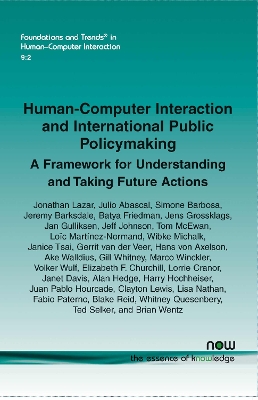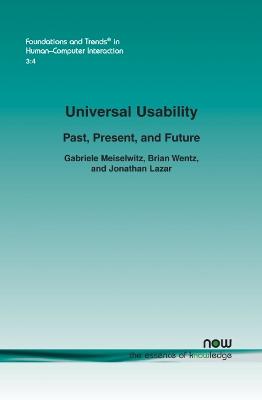Foundations and Trends (R) in Human-Computer Interaction
3 total works
This monograph lays out a discussion framework for understanding the role of human-computer interaction (HCI) in public policymaking. It takes an international view, discussing potential areas for research and application and their potential for impact. The aim is to provide a solid foundation for discussion, cooperation and collaborative interaction, and to outline future programs of activity.
It starts with an introduction to HCI and public policy and goes on to discuss how HCI research and practices already inform public policy, providing representative examples. It then discusses how public policy influences HCI and provides representative public policy areas that are relevant to HCI, and where HCI could have even more impact in the future. It concludes by laying out a framework for involvement and suggested actions by the HCI community in public policy internationally.
This monograph summarizes the observations and recommendations from a daylong workshop at the CHI 2013 conference in Paris, France. The workshop invited the community’s perspectives regarding the intersection of governmental policies, international and domestic standards, recent HCI research discoveries, and emergent considerations and challenges. It also incorporates contributions made after the workshop by workshop participants and by individuals who were unable to participate in the workshop but whose work and interests were highly related and relevant.
It starts with an introduction to HCI and public policy and goes on to discuss how HCI research and practices already inform public policy, providing representative examples. It then discusses how public policy influences HCI and provides representative public policy areas that are relevant to HCI, and where HCI could have even more impact in the future. It concludes by laying out a framework for involvement and suggested actions by the HCI community in public policy internationally.
This monograph summarizes the observations and recommendations from a daylong workshop at the CHI 2013 conference in Paris, France. The workshop invited the community’s perspectives regarding the intersection of governmental policies, international and domestic standards, recent HCI research discoveries, and emergent considerations and challenges. It also incorporates contributions made after the workshop by workshop participants and by individuals who were unable to participate in the workshop but whose work and interests were highly related and relevant.
Universal Usability
by Gabriele Meiselwitz, Brian Wentz, and Jonathan Lazar
Published 11 August 2010
Computers are used all over the world in a variety of contexts by users with all levels of technical experience. This includes users such as kindergarteners, older users, people with various impairments, people who are busy doing other tasks (such as driving a car), and users with differing levels of education, literacy, and socio-economic means. The concept of computer interfaces that will be easy to use, for all of these users, in all of these different situations, is known as universal usability.
Making progress towards this goal requires innovations in techniques for gathering and understanding requirements; designing and developing interfaces; evaluation and assessment; standards practices; and public policy, and much work in this field remains to be done. This survey presents an overview of universal usability as it currently exists in the human-computer interaction literature, and presents some future directions for work in universal usability.
Making progress towards this goal requires innovations in techniques for gathering and understanding requirements; designing and developing interfaces; evaluation and assessment; standards practices; and public policy, and much work in this field remains to be done. This survey presents an overview of universal usability as it currently exists in the human-computer interaction literature, and presents some future directions for work in universal usability.
Understanding Web Credibility
by Jonathan Lazar, Meiselwitz. Gabriele, and Jinjuan Feng
Published 5 October 2007
As more of our communication, commerce, and personal data goes online, credibility becomes an increasingly important issue. How do we determine if our e-commerce sites, our healthcare sites, or our online communication partners are credible?
Understanding Web Credibility focuses on the issues related to web credibility. It starts by examining the cognitive foundations of credibility. Other sections examine not only the general credibility of web sites, but also online communication, such as e-mail, IM, and online communities. Training and education, as well as future issues (such as CAPTCHAs and phishing), are also addressed. Finally, the implications for multiple populations (users, web developers, browser designers, and librarians) are discussed, along with some of the future threats to credibility.
The book provides a thorough reading for individuals interested in the topic of credibility.
Understanding Web Credibility focuses on the issues related to web credibility. It starts by examining the cognitive foundations of credibility. Other sections examine not only the general credibility of web sites, but also online communication, such as e-mail, IM, and online communities. Training and education, as well as future issues (such as CAPTCHAs and phishing), are also addressed. Finally, the implications for multiple populations (users, web developers, browser designers, and librarians) are discussed, along with some of the future threats to credibility.
The book provides a thorough reading for individuals interested in the topic of credibility.


